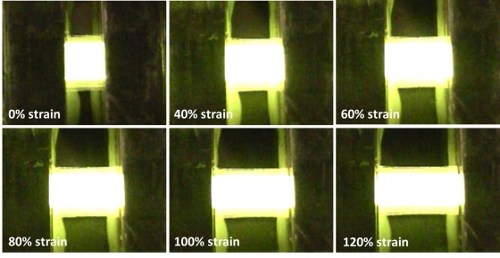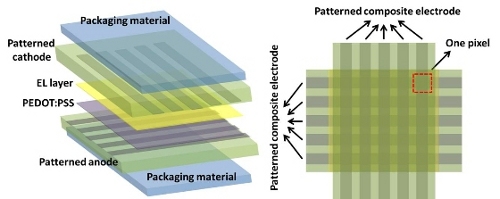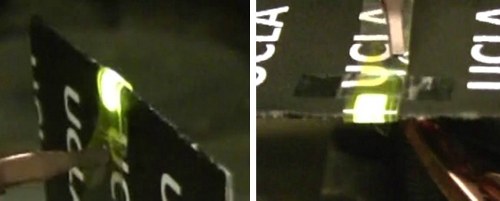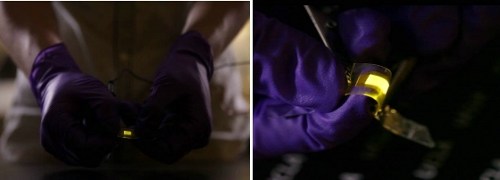 |
| February 11, 2014 | Volume 10 Issue 06 |
Designfax weekly eMagazine
Archives
Partners
Manufacturing Center
Product Spotlight
Modern Applications News
Metalworking Ideas For
Today's Job Shops
Tooling and Production
Strategies for large
metalworking plants
UCLA engineers develop a stretchable, foldable transparent electronic display
By Matthew Chin, UCLA
Imagine an electronic display nearly as clear as a window, or a curtain that illuminates a room, or a smartphone screen that doubles in size, stretching like rubber. Now imagine all of these being made from the same material.
Researchers from UCLA's Henry Samueli School of Engineering and Applied Science have developed a transparent, elastic organic light-emitting device, or OLED, that could one day make all these possible. The OLED can be repeatedly stretched, folded, and twisted at room temperature while still remaining lit and retaining its original shape.

OLED stretch test: Photographs of a stretchable OLED (original emission area: 5.0 mm x 4.5 mm) at specified strains (up to 120 percent).
OLED technology is used today in screens for many smartphones and some televisions. The new ultra-stretchable OLED material developed at UCLA could lead to foldable and expandable screens for new classes of smartphones and other personal electronic devices, electronics-integrated clothing, wallpaper-like lighting, new minimally invasive medical tools, and many other applications.
"Our new material is the building block for fully stretchable electronics for consumer devices," says Qibing Pei, a UCLA professor of materials science and engineering and principal investigator on the research. "Along with the development of stretchable thin-film transistors, we believe that fully stretchable interactive OLED displays that are as thin as wallpaper will be achieved in the near future. And this will give creative electronics designers new dimensions to exploit."

Organic light-emitting device: Schematic (left) and top-view (right) illustrations of an encapsulated fully stretchable OLED display comprising 5 x 5 pixels.
The research is published online in the peer-reviewed journal Nature Photonics. The lead author of the study is Jiajie Liang, a postdoctoral scholar in Pei's Soft Materials Research Laboratory at UCLA.
The researchers stretched and restretched the OLED 1,000 times, extending it 30 percent beyond its original shape and size, and it still continued to work at a high efficiency. In another test to determine the material's maximum stretch, the researchers found it could be stretched to more than twice its original size while still functioning. In addition, it can be folded 180 degrees and can be twisted in multiple directions.
The material has a single layer of an electro-luminescent polymer blend sandwiched between a pair of new transparent elastic composite electrodes. These electrodes are made of a network of silver nanowires inlaid into a rubbery polymer, which allows the device to be used at room temperatures. All of these layers are fully stretchable, foldable, and twistable. The new material can also be fabricated in a relatively simple all-solution-based process.

OLED foldover: Images of a stretchable OLED (original emission area: 3.0 mm x 7.0 mm) wrapped around the edge of a 400 &m thick cardboard paper.
"The lack of suitable elastic transparent electrodes is one of the major obstacles to the fabrication of stretchable display," Liang says. "Our new transparent, elastic composite electrode has high visual transparency, good surface electrical conductivity, high stretchability, and high surface smoothness -- all features essential to the fabrication of the stretchable OLED."
The team also demonstrated this ultra-flexible OLED could contain multiple pixels, rather than just a solid block of light. This could pave the way for electronic displays comprising many thousands of pixels. They accomplished this by assembling the silver nanowire-based electrodes into a cross-hatched pattern, with one layer of columns and one layer of rows.

OLED bending: An encapsulated OLED is stretched, bent, and wrapped around a finger.
"While we perceive a bright future where information and lighting are provided in various thin, stretchable, or conformable form factors, or are invisible when not needed, there are still major technical challenges," Pei says. "This includes how to seal these materials that are otherwise sensitive to air. Researchers around the world are racing the clock tackling the obstacles. We are confident that we will get there and introduce a number of cool products along the way."
Pei is also a member of the California NanoSystems Institute (CNSI) at UCLA.
Other authors of the study include Lu Li, a UCLA postdoctoral scholar; UCLA engineering graduate student Xiaofan Niu; and Zhibin Yu, a former UCLA doctoral student and postdoctoral scholar who is now a postdoctoral scholar at UC Berkeley.
The research was funded by the National Science Foundation and the Air Force Office of Scientific Research.
Published February 2014
Rate this article
View our terms of use and privacy policy
